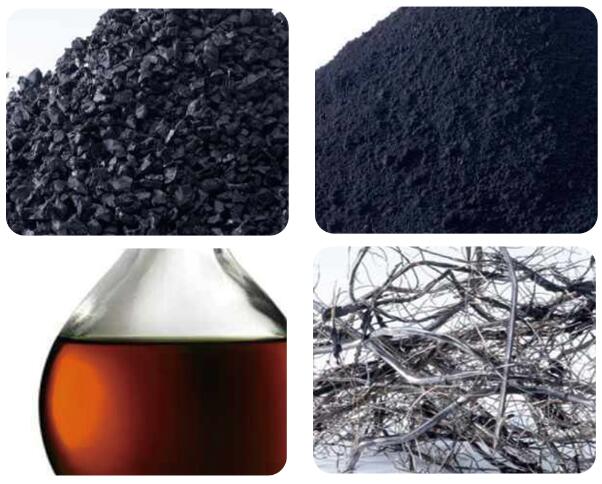"Green development is the background color of high-quality development, and the new quality productivity itself is green productivity." In recent years, Qunfeng Heavy Industry has implemented the "6G" green development concept, and is committed to becoming a leader in green manufacturing.
Several high-quality secondary raw materials are obtained in an environmentally friendly way in the unique and patented pyrolysis process of Qunfeng Heavy Industry:
Firstly, the components of used cars and truck tires are mechanically separated. The steel wires sorted out with the help of powerful metal separators are sent to steel mills and the textile fibers are turned into insulating materials. Rubber from used tires is shredded into granules in twin-shaft crushers and mills. Rubber granules with different particle sizes can be used to manufacture a variety of sustainable, durable products or recycled into other secondary raw materials.
In a pyrolysis plant, the rubber granules are broken down without oxygen into other valuable secondary raw materials: coke or rCB (Recycled Carbon Black) for the rubber and plastics industry, crude oil and natural gas for the chemical industry. In Qunfeng Heavy Industry's tire pyrolysis plants, the gas obtained is converted into electricity in a cogeneration unit. This makes the entire recycling plant self-sufficient in energy.

Reclaimed rubber is widely used in the production of various rubber products. Under the premise of ensuring the quality of rubber products, it is reasonable to mix part of the reclaimed rubber and reduce the amount of raw rubber, carbon black, rubber auxiliaries, and fillers, which not only saves the production cost but also helps to solve the environmental pollution brought by waste rubber.
High wear-resistant products: the proportion of about 50%. High abrasion-resistant products require high abrasion resistance, and other aspects of the index requirements are lower, in the production of more recycled rubber can be added to reduce production costs.
-Pressure molding, extruding industrial products: the proportion of about 20%. Reclaimed rubber is popular, plastic is better than natural rubber and synthetic rubber, expansion and shrinkage is small, easy to calender and extrusion, and is not prone to bubbles or rubber burning phenomenon. Used in the production of compression molded and extruded industrial products, it can reduce the scrap rate of products.
-Rubber sheet, vibration damping products, and other hard rubber products: the proportion of about 40%. The use of the appropriate amount of recycled rubber in such hard rubber products can improve the impact resistance of rubber products, vulcanization curve steep, reduce the product processing time and vulcanization time, and play a role in reducing costs and increasing efficiency.
-Conveyor belt: about 5% mixing ratio. Conveyor belt is a large category of rubber products, in the production process of a conveyor belt mixed with an appropriate amount of recycled rubber can improve the performance of the rubber calendering process, so that its apparent quality is better, especially in the conveyor belt rubbing rubber in the use of recycled rubber, but also to improve the wetting performance of the rubber, improve the rubbing rubber performance.
In recent years, some foreign material recycling industries, have been involved in waste tire pyrolysis, and pay special attention to the preparation and application of pyrolysis carbon black and recycled pyrolysis carbon black. China's Ministry of Science and Technology 2018 released the national key research and development plan "solid waste resource utilization" and other key special projects in the 2018 annual project declaration guide No. 6. 5 "waste passenger car tires efficient cracking and by-products comprehensive utilization technology" research content and assessment indicators. It is of guiding significance to the industry. Making full use of waste tire resources to develop the recycled rubber industry and do a good job of rubber recycling is not just a matter of waste tires, but a rubber recycling industry that covers all rubber products.